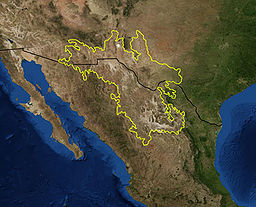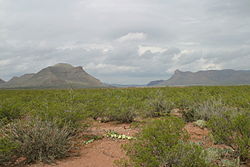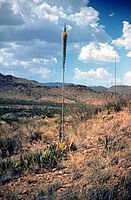- Chihuahuan Desert
-
Chihuahuan Desert Arid Region Ocotillo plant in the Chihuahuan DesertCountries Mexico, United States Region North America Coordinates 30°32′26″N 103°50′14″W / 30.54056°N 103.83722°W Highest point - elevation 1,675 m (5,495 ft) Lowest point - elevation 600 m (1,969 ft) Length 1,285 km (798 mi) Width 440 km (273 mi) Area 362,600 km2 (140,001 sq mi) Website: Centennial Museum, University of Texas at El Paso The Chihuahuan Desert is a desert, and an ecoregion designation, that straddles the U.S.-Mexico border in the central and northern portions of the Mexican Plateau, bordered on the west by the extensive Sierra Madre Occidental range, and overlaying northern portions of the east range, the Sierra Madre Oriental. On the U.S. side it occupies the valleys and basins of central and southern New Mexico, Texas west of the Pecos River and southeastern Arizona; south of the border, it covers the northern half of the Mexican state of Chihuahua, most of Coahuila, north-east portion of Durango, extreme northern portion of Zacatecas and small western portions of Nuevo León. With an area of about 362,000 km2 (139,769 sq mi), it is the third largest desert of the Western Hemisphere and the second largest in North America, after the Great Basin Desert.[1]
Contents
Geography
The terrain mainly consists of basins broken by numerous small mountain ranges.
Several larger mountain ranges include the Sierra Madre, the Sierra del Carmen, the Sacramento Mountains, the Sandia-Manzano Mountains, the Magdalena-San Mateo Mountains, the Chisos Mountains, the Guadalupe Mountains, and the Davis Mountains. These create "sky islands" of cooler, wetter, climates within the desert, and such elevated areas have both coniferous and broadleaf woodlands, and even forests along drainages and favored exposures.
The Chihuahuan Desert is higher in elevation than the Sonoran Desert to the west, mostly varying from 600–1,675 m (1,969–5,495 ft) in altitude. As a result, it tends to have a slightly milder climate in the summer (though usually daytime June temperatures are in the range of 35 to 40 °C / 95 to 104 °F). Winter weather varies from relatively mild to quite cold depending on altitude and the ferocity of northerly winds. Precipitation is somewhat more abundant than most of the southern Great Basin, the Sonoran, and Mojave deserts, however it is still usually less than 254 millimeters (10.0 in) per year, with much of the rain falling during the "monsoon" of late summer. The mean annual precipitation for the Chihuahuan Desert is 235 mm (9.3 in) with a range of approximately 150–400 mm (6–16 in). Nearly two-thirds of the arid zone stations have annual totals between 225 and 275 mm (8.9 and 10.8 in).[2] Snowfall is scant except at the higher elevation edges.
The Chihuahuan Desert is an ecoregion that has received little exploration and study. Therefore, it has not been classified or had subdivisions applied to it, as has the Sonoran Desert to the west.
There are a few urban areas within the desert: the largest is Ciudad Juárez with almost two million inhabitants, neighboring El Paso; then the city of Chihuahua and Torreón. Albuquerque, Las Cruces and Roswell in New Mexico are among the other significant cities in this ecoregion. Saltillo and Monterrey are located in the border of the Chihuahuan desert.
According to the World Wide Fund for Nature, the Chihuahuan Desert may be the most biologically diverse desert in the world, whether measured on species richness or endemism, although the region has been heavily degraded over time. Many native species have been replaced with Creosote Bush. The Mexican Wolf, once abundant, has been extirpated. The main cause of degradation has been grazing.[3]
Flora
Creosote Bush (Larrea tridentata) is the dominant plant species throughout the Chihuahuan Desert. The other species it is found with depends on factors such as the soil, altitude, and degree of slope. Creosote Bush, Viscid Acacia (Acacia neovernicosa), and Tarbush (Flourensia cernua) dominate the northern portion. Yucca and Opuntia species are abundant in the central third, while Arizona Rainbow Cactus (Echinocereus polyacanthus) and Mexican Fire-barrel Cactus (Ferocactus pilosus) inhabit the southernmost portion. Herbaceous plants, such as Blue Grama (Bouteloua gracilis), Gypsum Grama (B. breviseta), and Hairy Grama (B. hirsuta), are dominant near the Sierra Madre Occidental. Lechuguilla (Agave lechuguilla), Honey Mesquite (Prosopis glandulosa), Opuntia macrocentra and Echinocereus pectinatus are the dominant species in western Coahuila. Anacahuita (Cordia boissieri), Ocotillo (Fouquieria splendens), Lechuguilla, and Yucca filifera are the most common species in the southeastern part of the desert. Candelilla (Euphorbia antisyphilitica), Mimosa zygophylla, Acacia glandulifera and Lechuguilla are found in areas with well-draining, shallow soils. The shrubs found near the Sierra Madre Oriental are exclusively Lechuguilla, Guapilla (Hechtia glomerata), Queen Victoria's Agave (Agave victoriae-reginae), Sotol (Dasylirion spp.), and Barreta (Helietta parvifolia), while the well-developed herbaceous layer includes grasses, legumes and cacti. Grasslands comprise 20% of this desert and are often mosaics of shrubs and grasses. They include Purple Three-awn (Aristida purpurea), Black Grama (Bouteloua eriopoda), and Sideoats Grama (Bouteloua curtipendula). Early Spanish explorers reported encountering grasses that were "belly high to a horse;" most likely these were Big Alkali Sacaton (Sporobolus wrightii) and Tobosa (Pleuraphis mutica) bottomlands.[3]
-
Lechuguilla (Agave lechuguilla)—one of the indicator plants of the Chihuahuan Desert
See also
Wikimedia Commons has media related to: References
- ^ Wright, John W. (ed.); Editors and reporters of The New York Times (2006). The New York Times Almanac (2007 ed.). New York, New York: Penguin Books. pp. 456. ISBN 0-14-303820-6.
- ^ Chihuahuan Climate, Chihuahuan Desert Research Institute
- ^ a b "Chihuahuan desert (NA1303)". WildWorld Full Reports. World Wild Fund for Nature. http://www.worldwildlife.org/wildworld/profiles/terrestrial/na/na1303_full.html. Retrieved 2010-10-22.
External links
- Chihuahuan Desert images at bioimages.vanderbilt.edu (slow modem version)
- Pronatura Noreste in the Chihuahuan Desert
- Small desert beetle found to engineer ecosystems EurekAlert! March 27, 2008
World deserts Africa Asia - Ad-Dahna
- Arabian
- Aral Karakum
- Aralkum
- Badain Jaran
- Betpak-Dala
- Cholistan
- Dasht-e Kavir
- Dasht-e Lut
- Dasht-e Margoh
- Dasht-e Naomid
- Gurbantünggüt
- Gobi
- Hami
- Indus Valley
- Judean
- Karakum
- Kharan
- Kumtag
- Kyzyl Kum
- Lop
- Nefud
- Negev
- Ordos
- Qaidam
- Rub' al Khali
- Russian Arctic
- Registan
- Saryesik-Atyrau
- Syrian
- Taklamakan
- Tengger
- Thal
- Thar
- Tihamah
- Ustyurt Plateau
- Wahiba Sands
- Liwa
Europe North America - Alvord
- Amargosa
- Baja California
- Black Rock
- Carcross
- Channeled scablands
- Chihuahuan
- Escalante
- Forty Mile
- Gran Desierto de Altar
- Great Basin
- Great Salt Lake
- Great Sandy
- Jornada del Muerto
- Kaʻū
- Lechuguilla
- Mojave
- North American Arctic
- Owyhee
- Painted Desert
- Red Desert
- Sevier
- Smoke Creek
- Sonoran
- Tule (Arizona)
- Tule (Nevada)
- Yp
- Yuha
- Yuma
Australia South America Polar regions New Zealand Categories:- Chihuahuan Desert
- Deserts and xeric shrublands in the United States
- Ecoregions of the United States
- Deserts and xeric shrublands
- Ecoregions of Mexico
- Deserts of Mexico
- Deserts of New Mexico
- Deserts of Texas
- Deserts of Arizona
- Southwestern United States
- Regions of Northern Mexico
- Natural history of Chihuahua
- Natural history of Coahuila
- Natural history of Durango
- Natural history of Zacatecas
- Natural history of Nuevo León
- Mexican Plateau
- Deserts of North America
Wikimedia Foundation. 2010.





